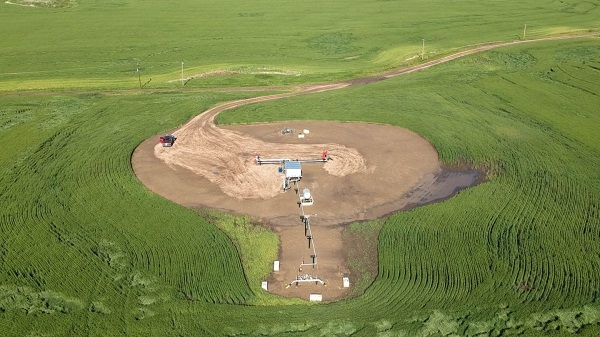Education
Celebrating BMO’s community investment in RDC

From Red Deer College
BMO Financial Group’s support honoured at unveiling event
Red Deer, January 21, 2019 – At an event in the Gary W. Harris Canada Games Centre/Centre des Jeux du Canada Gary W. Harris this morning, Red Deer College proudly unveiled the BMO Financial Group Wellness Studio.
In recognition of their $300,000 contribution toward RDC’s Shaping Our Future campaign, the loft-like space above the south end of Builders’ Hall in RDC’s newest facility has been named for the next five years.
This stunning space is a vital component of the Collicutt Performance Fitness Zone, and is used for fitness classes, yoga and meditation. The BMO Financial Group Wellness Studio’s floor-to-ceiling windows look out over the NOVA Chemicals Waskasoo Creek Nature Walk on the south end, and Builders’ Hall to the north. This bright, quiet space contributes to the building’s holistic approach toward wellness by providing an indoor fitness space that connects users to the natural landscape beyond its walls, supporting an individual’s spiritual, environmental and physical wellness.
BMO Financial Group is a committed community partner, and has supported RDC as a proud donor and sponsor in the past and with other initiatives. Their most recent contribution to Red Deer College and the Shaping Our Future campaign is an investment in the health and wellness of RDC students as well as the community members who use the College’s newest facility.
For Red Deer College, this community investment reinforces the support of industry and local businesses for the role that RDC plays in the region.
“We’re grateful, and proud to acknowledge, the strong support that BMO Financial Group has provided to Red Deer College, to support our students and community today and in the future,” says Joel Ward, RDC President & CEO. “We have a shared vision for our region, as community leaders who recognize that we have the power to shape the future of our region, our province and our communities by investing in the total wellness of our citizens.”
The Gary W. Harris Canada Games Centre, which is perhaps the most recognizable result of the Shaping Our Future campaign, is only one component of the work RDC has been able to accomplish with the support of community partners like BMO Financial Group.
The College has increased its footprint by nearly a third, with new infrastructure projects including an Alternative Energy Lab and New Residence. RDC has also developed new programs and enhanced existing programs that prepare graduates for success within new and emerging careers that support central Alberta businesses in a diverse and changing economy. All of this will ensure RDC can best continue to serve our learners and communities as we become a comprehensive regional teaching university.
About RDC: For 55 years, RDC has been proudly serving its learners and communities. The College continues to grow programs, facilities and opportunities as it transitions to become a comprehensive regional teaching university during the next three to five years. This year, RDC will add seven new programs to more than 100 established programs (including full degrees, certificates, diplomas and skilled trades programs). RDC educates 7,500 full-and part-time credit students and more than 38,000 youth and adult learners in the School of Continuing Education each year. The College is expanding its teaching, learning, athletic and living spaces with the additions of the state-of-the-art Gary W. Harris Canada Games Centre/Centre des Jeux du Canada Gary W. Harris, Alternative Energy Lab and construction of a new Residence which all enhance RDC’s Alternative Energy Initiative. Main campus is strategically situated on 290 acres of Alberta’s natural landscape along Queen Elizabeth II Highway. RDC is also proud to serve its Donald School of Business students housed at a downtown campus, located in the Millennium Centre, in addition to housing teaching and learning space at the Welikoklad Event Centre.
Alberta
Alberta poll shows strong resistance to pornographic material in school libraries

From LifeSiteNews
A government survey revealed strong public support, particularly among parents, for restricting or banning sexually explicit books.
Albertans are largely opposed to their children viewing pornography in school libraries, according to government polling.
In a June 20 press release, the Government of Alberta announced that their public engagement survey, launched after the discovery of sexually explicit books in school libraries, found that Albertans strongly support removing or limiting such content.
“Parents, educators and Albertans in general want action to ensure children don’t have access to age-inappropriate materials in school libraries,” Demetrios Nicolaides, Minister of Education and Childcare, said.
“We will use this valuable input to guide the creation of a province-wide standard to ensure the policy reflects the priorities and values of Albertans,” he continued.
READ: Support for traditional family values surges in Alberta
The survey, conducted between May 28 to June 6, received nearly 80,000 responses, revealing a widespread interest in the issue.
While 61 percent of respondents said that they had never previously been concerned about children viewing sexually explicit content in libraries, most were opposed to young children viewing it. 34 percent said children should never be able to access sexually explicit content in school libraries, while 23 percent believed it should be restricted to those aged 15 and up.
Similarly, 44 percent of parents of school-aged children were supportive of government regulations to control content in school libraries. Additionally, 62 percent of respondents either agreed or strongly agreed that “parents and guardians should play a role in reporting or challenging the availability of materials with sexually explicit content in school libraries.”
READ: Alberta Conservatives seeking to ban sexually graphic books from school libraries
The polling results come after the Conservative Alberta government under Premier Danielle Smith announced that they are going ahead with plans to eventually ban books with sexually explicit as well as pornographic material, many of which contain LGBT and even pedophilic content, from all school libraries, on May 27.
At the time, Nicolaides revealed that it was “extremely concerning” to discover that sexually explicit books were available in school libraries.
The books in question, found at multiple school locations, are Gender Queer, a graphic novel by Maia Kobabe; Flamer, a graphic novel by Mike Curato; Blankets, a graphic novel by Craig Thompson; and Fun Home, a graphic novel by Alison Bechdel.
David Clinton
Why Are Ontario’s Public Schools So Violent?


 David Clinton
David Clinton
Ontario’s Auditor General just released a performance audit on the Toronto District School Board. I’m sure it’ll surprise exactly no one that “financial and capital resources are not consistently allocated in the most cost-effective or efficient way” or that “The effective management of operations was not always being measured and assessed for internal decision-making”.
And there was plenty of institutional chaos:
“Between 2017/18 and 2022/23…about 38% of TDSB schools did not report conducting the minimum number of fire drills required by the Ontario Fire Code annually, and about 31% of TDSB schools did not report conducting the minimum number of lockdown drills required by TDSB policy annually. The TDSB does not have an effective process to ensure the required number of drills are performed by each school, each year, or that they are performed in accordance with TDSB policy when performed.”
What else would you expect from a massive government bureaucracy that employs 40,000 people, spends $3.6 billion annually and – based on many of the highlighted items on their website – is laser-focused on pretty much anything besides education?
What you might not have seen coming was that around half of the report centered on in-school violence. To be sure, we’re told that there were only 407 violent events reported to the board during the 2022/2023 school year – which is a rate of around 17 events for every 10,000 students. 17:10,000 doesn’t exactly sound like an environment that’s spiraling out of control.
There was a caveat:
“Due to input errors by principals, the TDSB underreported the number of violent incidents that occurred between 2017/18 to 2021/22 to the Ministry by about 9%.”
Ok. But we’re still nowhere near Mad Max levels of violence. So what’s attracting so much of the auditor’s attention? Perhaps it’s got something to do with a couple of recent surveys whose results don’t quite match the board’s own records. Here’s how the audit describes the first of those:
“The 2022/23 TDSB Student and Parent Census was responded to by over 138,000 students, parents, guardians and caregivers. It showed that 23% of students in Grades 4 to 12 that responded to the survey said they were physically bullied (e.g., grabbed, shoved, punched, kicked, tripped, spat at), and about 71% stated they were verbally bullied (e.g., sworn at, threatened, insulted, teased, put down, called names, made fun of). Further, about 14% of student respondents indicated they had been cyberbullied. TDSB’s central tracking of all bullying incidents is much lower than this, suggesting that they are not centrally capturing a large number of bullying incidents that are occurring.”
“23% of students in Grades 4 to 12 that responded to the survey said they were physically bullied”. That’s not a great fit with that 17:10,000 ratio, even if you add the 9 percent of underreported incidents. And bear in mind that these students and their families were willing to discuss their experiences in a survey run by the school board itself, so it’s not like they’re hard to find.
But that’s not the worst of it. The Elementary Teachers’ Federation of Ontario (ETFO) ran their own survey in 2023. They wanted to hear about their members’ experiences with workplace violence. Here, quoting from the audit report, is what TDSB respondents told them:
- 42% had experienced physical force against themselves in 2022/23;
- 18% had experienced more than 10 of these physical force incidents in 2022/23;
- 81% indicated the number of violent incidents increased since they started working;
- about 77% responded that violence was a growing problem at their school;
- about 29% indicated they had suffered a physical injury;
- 57% had suffered a psychological injury/illness (such as mental stress, psychological or emotional harm) as a result of workplace violence against them; and
- about 85% indicated that violence at their school made teaching and working with students more difficult.
29 percent of teachers suffered a physical injury due to workplace violence. That’s elementary school teachers we’re talking about.
For perspective, even accounting for the 9 percent underreporting, the TDSB was aware of events impacting less than a quarter of a percentage point of their students (and apparently didn’t report any violence against teachers). But by their own accounts, 23 percent of all students and 42 percent of elementary teachers have suffered attacks. Are board officials willfully ignoring this stuff?
And if only there was some way to address violence and other criminal activities on school property. Perhaps – and I’m just spitballing here – there could even be people working in schools whose job it would be to (what’s the word I’m looking for?) police crime.
On a completely unrelated note, back in November, 2017, the Toronto District School Board voted 18-3 to permanently end their School Resource Officer (SRO) program. Since then, police officers have been unwelcome on board property.
To be sure, the TDSB has “accepted” all 18 of the report’s recommendations. But talk is cheap. Who’s to say that commitment won’t play out the same way we’ve seen with their fire drill compliance.
Can you spell “class action lawsuit”?
-

 Agriculture2 days ago
Agriculture2 days agoCanada’s supply management system is failing consumers
-

 Economy2 days ago
Economy2 days agoTrump opens door to Iranian oil exports
-

 Alberta1 day ago
Alberta1 day agoCOVID mandates protester in Canada released on bail after over 2 years in jail
-

 Business1 day ago
Business1 day agoCanada’s loyalty to globalism is bleeding our economy dry
-

 Crime1 day ago
Crime1 day agoProject Sleeping Giant: Inside the Chinese Mercantile Machine Linking Beijing’s Underground Banks and the Sinaloa Cartel
-

 Alberta1 day ago
Alberta1 day agoAlberta uncorks new rules for liquor and cannabis
-

 Business1 day ago
Business1 day agoCarney’s spending makes Trudeau look like a cheapskate
-

 armed forces23 hours ago
armed forces23 hours agoCanada’s Military Can’t Be Fixed With Cash Alone






